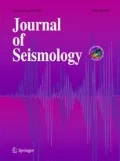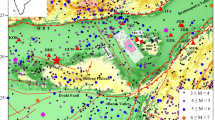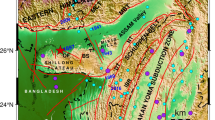Abstract
State of Uttaranchal in the northern part of India in the Garhwal Himalaya was hit by the Chamoli earthquake on 28th March, 1999 (GMT). This earthquake was recorded on a strong motion array installed in this region. The maximum peak ground acceleration of 353 cm/sec2 was recorded at an accelerograph located at the Gopeshwar station at an approximate epicentral distance of 14 km. The simplified method of Midorikawa (1993) has been used to model finite fault responsible for causing the Chamoli earthquake. This method is based on the Empirical Green's Function (EGF) technique of Irikura (1986).Modifications in this method have been made to include layered earth model and transmission effects at each boundary by Joshi (2001). Rupture causing the Chamoli earthquake is placed in two structural models of the earth in this work: one is a homogeneous half space and other is the multi layered earth model. Comparison in terms of root mean square error (RMSE) is made between the simulated and actual strong motion parameters like peak acceleration and duration. It is seen that the introduction of multi layered earth system in this simplified technique is capable of significantly reducing the RMSE in observed and predicted strong motion parameters and defining the attenuation rate for peak ground acceleration of this earthquake.
Similar content being viewed by others
References
Abrahamson, N.A. and Litehiser, J.J., 1989, Attenuation of vertical peak acceleration, Bull. Seis. Soc. Am. 79, 549–580.
Boore, D.M., 1983, Stochastic simulation of high frequency ground motion based on seismological models of radiated spectra, Bull. Seismol. Soc. Am. 73, 1865–1894.
Boore, D.M. and Atkinson, C.M., 1987, Stochastic prediction of ground motion and spectral response parameters at hard rock sites in eastern north America, Bull. Seismol. Soc. Am. 77, 440–467.
Campbell, K.W., 1997, Empirical near source attenuation relationships for horizontal and vertical components of peak ground acceleration, peak ground velocity, and pseudo absolute acceleration response spectra, Seism. Res. Lett. 68, 154–179.
Campbell, K.W., 2000, Erratum to ‘Empirical near source attenuation relationships for horizontal and vertical components of peak ground acceleration, peak ground velocity, and pseudo-absolute acceleration response spectra’ by Kenneth W. Camp-bell, Seism. Res. Lett. 71, 353–355.
Chandrasekaran, A.R. and Das, J.D., 1992, Analysis of strong ground motion accelerogram of Uttarkashi Earthquake of October 20, 1991, Bull. Indian Soc. of Earthquake Tech. 29, 35–55.
Chandrasekaran, A.R. and Das, J.D., 1991, Analysis of strong ground motion accelerograms of Uttarkashi earthquake of October 20, 1991, EQ 91-10, Department of Earthquake Engineering, University of Roorkee, Roorkee, India.
Cocco, M. and Boatwright, J., 1993, The envelopes of acceleration time histories, Bull. Seism. Soc. Am. 83, 1095–1114.
EERI, 1999, The Chamoli, India, earthquake of March 29, 1999, EERI Special earthquake report downloaded from internet (http://www.eeri.org/Reconn/Chamoli99/Chamoli032999.html)
Hartzell, S.H., 1978, Earthquake aftershocks as green functions, Geoph. Res. Lett. 5, 1–4.
Hartzell, S.H., 1982, Simulation of ground accelerations for May 1980 Mammoth Lakes, California earthquakes, Bull. Seismol. Soc. Am. 72, 2381–2387.
Hadley, D.M. and Helmberger, D.V., 1980, Simulation of strong ground motions, Bull. Seismol. Soc. Am. 70, 617–610.
Hanks, T.C. and McGuire, R.K., 1981, Character of high frequency ground motion, Bull. Seismol. Soc. Am. 71, 2071–2095.
Housner, G.W. and Jemiings, P.C., 1964, Generation of artificial earthquakes, Proc. ASCE 90, 113–150.
Hutchings, L., 1985, Modelling earthquakes with empirical green's functions (abs), Earthquake Notes 56, 14.
Irikura, K., 1983, Semi empirical estimation of strong ground mo-tion during large earthquakes, Bull. Dis. Prev. Res. Inst. (Kyoto Univ.) 33, 63–104.
Irikura, K., 1986, Prediction of strong acceleration motion using empirical greens function, Proc. 7th Japan Earthquake Enging. Symp., pp. 151–156.
Irikura, K. and Muramatu, I., 1982, Synthesis of strong ground motions from large earthquakes using observed seismograms of small events, Proc. 3rd Int. Microzonation Conprence, Seattle, pp. 447–458.
Jain, A.K. and Chander, R., 1995, Geodynamic models for Uttarkashi earthquake of October 20, 1991, Uttarkashi Earthquake, Geol. Soc. India, pp. 225–233.
Joshi, A., 1997, Modelling of peak ground acceleration for Uttarkashi earthquake of 20th October, 1991, Bull. Ind. Soc. Earthquake Tech. 34, 75–96.
Joshi, A. and Patel, R.C., 1997, Modelling of active lineaments for predicting possible earthquake scenario around Dehradun, Garhwal Himalaya, India, Tectonophysics 283, 289–310.
Joshi, A., 1998, Study of the Uttarkashi earthquake in terras of rupture model and isoseismals, J. Geophys. 19, 133–140.
Joshi, A., Kumar, B., Sinvhal, A. and Sinvhal, H., 1999, Generation of synthetic accelerograms by modelling of rupture plane, J. Indian Soc. Earthqua. Tech. 36, 43–60.
Joshi, A., 2000, Modelling of rupture planes for peak ground accelerations and its application to the isoseismal map of MMI scale in Indian region, J. Seismol. 4, 143–160.
Joshi, A., Singh, S. and Girothi, Kavita, (2001), The simulation of ground motions using envelope summations, Pure Appl. Geophys. 158, 877–901.
Joshi, A. and Midorikawa, S., 2001, Attenuation characteristics of ground motion intensity from earthquakes with intermediate depth, PAGEOPH (Communicated).
Kamae, K. and Irikura, K., 1992, Prediction of site specific strong ground motion using semi empirical methods, Earthquake Enging. 10th World Conf., pp. 801–806.
Kameda, H. and Sugito, M., 1978, Prediction of strong earthquake motions by evolutionary process model, Proc. 6th Japan Earthquake Enging. Symp., pp. 41–48.
Kanamori, H., 1979, A semi empirical approach to prediction of long period ground motions from great earthquakes, Bull. Seismol. Soc. Am. 69, 1645–1670.
Kanamori, H. and Anderson, D.L., 1975, Theoretical basis of some empirical relation in seismology, Bull. Seismol. Soc. Am. 65, 1073–1095.
Kumar, D., Teotia, S.S. and Khattri, K.N., 1997, The representation of attenuation characteristics of strong ground motions observed in the 1986 Dharamsala and 1991 Uttarkashi earthquakes by available empirical relations, Curr. Sci. 73, 543–548.
Lai, S.P., 1982, Statistical characterization of strong ground motions using power spectral density function, Bull. Seismol. Soe. Am. 72, 259–274.
Lay, T. and Wallace, T.C., 1995, Modern Global Seismology, Academic Press, California, pp. 521.
Lee, W.H.K. and Stewart, S.W., 1981, Principles and Applications of Micro-earthquake Networks, Academic Press, New York, pp. 293.
Mandal, P., Pandy, S., Rastogi, B.K., Satyanarayana, H.V.S., Kous-alya, M., Vijayaghavan, R. and Srinivasan, A., 2001, Aftershock activity and frequency dependent low coda Qc in the epicentral region of the 1999 Chamoli earthquake of Mw 6.4, Pure App. Geophys. 158, 1719–1735.
McGuire, R.K., 1977, Seismic design spectra and mapping procedures using hazard analysis based directly on oscillator response, J. Earthquake Eng. Strut. Dyn. 5, 211–234.
Mendoza, C. and Hartzell, S., 1988, Inversion for slip distribution using teleseismic P waveforms, North Palm Springs, Borah Peak, and Michoacan earthquakes, Bull. Seismol. Soc. Am. 78, 1092–1111.
Metcalfe, R.P., 1993, Pressure, temperature and time constraints on metamorphism across the Main Central Thrust zone and High Himalayan Slab in Garhwal Himalaya, Himalayan Tectonics, Geol. Soc. Sp. Publ. 74, In: Treloar, P.J. and Searle, M.P. (eds.), pp. 485–510.
Midorikawa, S. and Kobayashi, H., 1978, On estimation of strong earthquake motions with regards to fault, In: Proc. 2nd Int. Conf. on Microzonation 2, pp. 825–836.
Midorikawa, S., 1993, Semi empirical estimation of peak ground acceleration from large earthquakes, Tectonophysics 218, 287–295.
Midorikawa, S., 1989, Synthesis of ground acceleration of large earthquake using acceleration envelope waveform of small earthquake, J. Struct. Const. Enging. 398, 23–30 (Japanese).
Mikumo, T., Irikura, K. and Imagawa, K., 1981, Near field strong motion synthesis front foreshock and aftershock records and rupture process of the main shock fault, (abs.), IASPEI 21st General Assembly, London.
Mugnuia, L. and Brune, J.M., 1984, Simulations of strong ground motions for eathquakes in the Mexicali-Imperial valley, Proc. of workshop on Strong Ground Motion Simulation and Earthquake Engng. Appl., Pub. 85-02 Earthquake Engineering Research Institue, Los Altos, California, 21-1-21-19.
Negi, R.S., Nawani, P.C., Rawat, J.S., Agarwal, K.K., Sawat, P.V., Gairola, B.M., Tripathi, S.K., Khanduri, K.C., Singh, Bhupendra, Dangwal, D.P., 1999, Macroseismic effects and related geotechnical problems caused by Chamoli earthquake on 29th March, 1999 in parts of Garhwal Himalaya, (Abs.), Workshop on Chamoh earthquake and its impact, Department of Science and Technologe, India.
Pande, P., Singh, R.K., Gupta, S.K., Joshi, K.C., 1999, A Review of seismotectonics of Garhwal HimalayaAn explanation of the mechanics of 29th March, 1999 Chamoli earthquake, (Abs.), Workshop on Chamoli earthquake and its impact, Department of Science and Technology, India.
Paul, S.K., Rautela, P. and Lakhera, R.C., 1999, Interrelationship of co-seismic fractures with tectonic setup of the area: A study of 28th March, 1999 Chamoli earthquake, (Abs.), Workshop on Chamoli earthquake and its impact, Department of Science and Technology, India.
Rastogi, B.K., 2000, Chamoli earthquake of Magnitude 6.6 on 29 March, 1999, J. Geol. Soc. India 55, 505–514.
Saikia, C.K. and Herrmann, R.B., 1985, Application of wave-form modelling to determine focal mechanisms of four 1982 Miramichi aftershocks, Bull. Seism. Soc. Am. 75, 1021–1040.
Saikia, C.K., 1993, Ground motion studies in Great Los Angles due to Mw = 7.0 Earthquake on the Elysian Thrust Fault, Bull. Seism. Soc. Am. 83, 780–810.
Sharma, M.L., 1998, Attenuation relationship for estimation of peak ground horizontal acceleration using data from strong motion array in India, Bull. Seism. Soc. Am. 88, 1063–1069.
Spudich, P., Joyner, W.B., Lindh, A.G., Boore, D.M., Margaris, B.M. and Fletcher, J.B., 1999, SEA99: A revised groiuid motion prediction relation for use in extensional tectonic regimes, Bull. Seim. Soc. Am. 89, 1156–1170.
Thakur, V.C. and Rohella, R.K., 1999, Geodynamic model for Chamoli earthquake of March 29, 1999 and seismic hazard assesment in the Garhwal Kumaon region, Workshop on Chamoli earthquake and its impact, Department of Science and Technology, India.
Trifunac, M.D. and Brady, A.G., 1975, A study on the duration of strong earthquake ground motion, Bull. Seismol. Soc. Am. 65, 581–627.
Valdiya, K.S., 1977, Structural setup of the Kumaon lesser Himalaya, In: Himalayan Secience de la terre, Centre Nationale Richerche Science, Paris 268, 449–462.
Wells, L.D. and Coppersmith, K.J., 1994, New empirical relationships among magnitude, rupture length, rupture width, rupture area and surface displacement, Bull. Seismol. Soc. Am. 84, 974–1002.
Youngs, R.R., Chious, S.J., Silva, W.J. and Humphrey, J.R., 1997, Strong motion attenuation relationships for subduction zone earthquakes, Seism. Res. Lett. 68, 58–73.
Yu, G., 1994, Some aspect of earthquake seismology: slip partitioning along major convergent plate boundaries; composite source model for estimation of strong motion; and nonlinear soil response modelling, Ph.D. thesis, University of Nevada, Reno.
Yu, G., Khattri, K.N., Andersom, J.G., Brune, J.N. and Zeng, Y., 1995, Strong ground motion from the Uttarkashi earthquake, Himalaya, India, Earthquake: Comparison of Observations with Synthetics Using the composite source model, Bull. Seismol. Soc. Am. 85, 31–50.
Zeng, Y., Anderson, J.G. and Su, F., 1994, A composite source model for computing realistic synthetic strong ground motions, Geophys. Res. Lett. 21, 725–728.
Author information
Authors and Affiliations
Rights and permissions
About this article
Cite this article
Joshi, A. Predicting strong motion parameters for the Chamoli earthquake of 28th March, 1999, Garhwal Himalaya, India, from simplified finite fault model. Journal of Seismology 7, 1–17 (2003). https://doi.org/10.1023/A:1021211608515
Issue Date:
DOI: https://doi.org/10.1023/A:1021211608515




